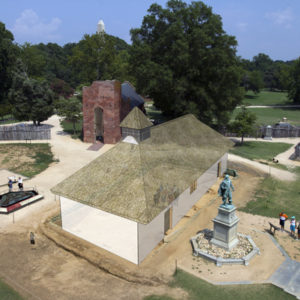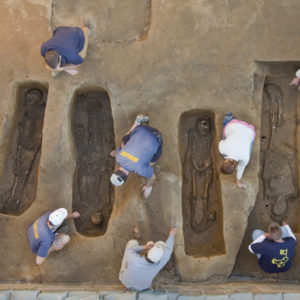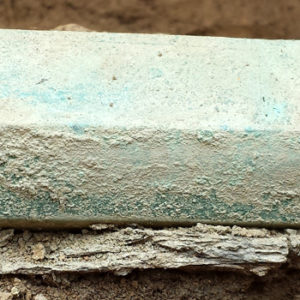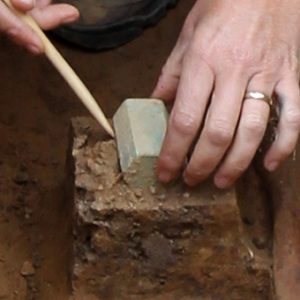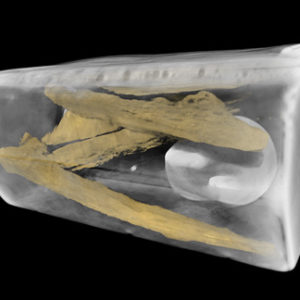In 23 years of research, the Jamestown Rediscovery team has found the lost James Fort and the lost 1608 church within the fort, and now the team has recovered the identities of the four Jamestown leaders buried within that church.
When the footprint of the 1608 church was excavated in 2011, archaeologists found four graves in a 24-foot by 12-foot space at the east end of the church. This was the church’s chancel–a space in the Anglican Church commonly reserved during services for the clergy, government officials, and the altar table. The chancel also was a space where individuals of high status would be buried. These four graves were dug sometime between January of 1608, when the church was constructed, and 1617, when it fell into disrepair and was re-sited a few dozen yards to the northeast.
The church site was refilled to keep the area safe for visitors, but in November 2013 the Jamestown Rediscovery archaeologists returned to the four graves to see if they could discover who was in each one. Excavating them was important because the preservation environment was poor and would only continue to deteriorate due to rising sea levels, which threaten much of Jamestown Island. It was also a way to honor the leaders whose resting place had been forgotten. (With no sense of where the original fort was, in 1938 workers dug a trench through the chancel area to place an electrical line to service a water pump for the Dale House near the seawall; the trench damaged one of the four graves.)
Working with forensic anthropologists from the Smithsonian’s National Museum of Natural History, the team meticulously recorded the burials to ensure the information observed in the field could be reconstructed and used by future researchers. Archaeologists used a laser transit integrated with an electronic distance measuring unit (EDM) to accurately record positions of the graves, coffin remains, artifacts, and bones. Once the skeletal remains in all four graves were exposed, the Jamestown Rediscovery team and Smithsonian’s X 3D unit collected millions of points with a laser scanner and hundreds of photographs of the site. These were compiled to create an interactive 3D model of the chancel graves.
Examination of the remains of the four individuals showed that three were buried in coffins and one in a shroud. The wood of the coffins had decayed, but nail patterns indicate two coffins were anthropomorphic (human-shaped) in form. This unique construction would have required a skilled cabinetmaker. One of these individual also had remnants of silver threads from a garment worn at the time of burial. Another grave had a piece of what could be a captain’s leading staff (similar to the one found on top of the burial of Captain Bartholomew Gosnold) and a silver box that has religious significance.
Investigators compiled the clues from the bones and burials and then looked at supporting evidence. Historical sources note that five prominent men died during the years when the church was in use. These men ranged in age from the early 20s to the late 40s. Each might have been a man in these graves. Firsthand accounts of the deaths of four of these men best fit the evidence from the graves and human remains in the chancel of Jamestown’s early church. They are:
- The Reverend Robert Hunt was the first Anglican (Church of England) minister at Jamestown. He arrived with the first settlers and was responsible for providing religious services to the men as well as for preaching to local Indian peoples.
- Captain Gabriel Archer, a vociferous critic and rival of Captain John Smith, was one of the most important of the early leaders, involved in much of the in-fighting that characterized the colony’s first few years. Resting on top of Archer’s coffin, the team discovered a small, silver box, which was found to contain shards of bone and a tiny lead ampulla that would have held holy water, oil, or even blood. The presence of the reliquary, a sacred object normally (but not exclusively) associated with Catholicism may suggest Archer was a secret Catholic. Alternatively, it is possible the object had significant meaning in the founding of the established church, the Church of England, in the New World.
- Sir Ferdinando Wainman was a kinsman of the governor, Lord De La Warr, and a high ranking officer who was appointed master of ordnance (artillery) and placed in charge of the colony’s horse troops.
- Captain William West was also a relative of Lord De La Warr and was killed in fighting against elite Virginia Indian warriors in the fall or winter 1610.
related images
- This illustration of the 1608 church hovers over the archaeological site of the church, excavated by Jamestown Rediscovery in 2011.
- In the east end of the 1608 church were four burials. The chancel of an Anglican Church was reserved for the graves of very important people. But the identities of these four had been lost to time.
- In one chancel burial, archaeologists found a silver box resting on wood from the casket.
- Jamestown Rediscovery senior archaeologist Jamie May removes the silver box from a pedestal of soil in the grave shaft.
- The latest imaging technology has looked inside the silver box to find bone fragments and what appears to be an opened container for holy water.



